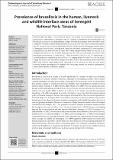| dc.contributor.author | Shirima, Gabriel | |
| dc.contributor.author | Kunda, John | |
| dc.date.accessioned | 2020-03-27T10:25:52Z | |
| dc.date.available | 2020-03-27T10:25:52Z | |
| dc.date.issued | 2016-05-24 | |
| dc.identifier.uri | https://doi.org/10.4102/ojvr.v83i1.1032 | |
| dc.identifier.uri | https://dspace.nm-aist.ac.tz/handle/20.500.12479/679 | |
| dc.description | This research article published by AOSIS, 2016 | en_US |
| dc.description.abstract | Between 2005 and 2006, a cross-sectional survey was carried out in domestic ruminants in agropastoral communities of Serengeti district, Tanzania to determine the seroprevalence of brucellosis in domestic-wildlife interface villages. Both the Rose Bengal Plate Test (RBPT) and Competitive Enzyme Linked-immunosorbent Assay (c-ELISA) were used to analyse 82 human and 413 livestock sera from four randomly selected villages located along game reserve areas of Serengeti National Park. Although both cattle (288) and small ruminants (125) were screened, seropositivity was detected only in cattle. The overall seroprevalence based on c-ELISA as a confirmatory test was 5.6%. In cattle both age and sex were not statistically associated with brucellosis seropositivity (P = 0.63; 95% CI = 0.03, 0.8 and 0.33; 95% CI = 0.6, 3.7, respectively). Overall herd level seropositivity was 46.7% (n = 7), ranging from 25% to 66.7% (n = 4-10). Each village had at least one brucellosis seropositive herd. None of the 82 humans tested with both RBPT and c-ELISA were seropositive. Detecting Brucella infection in cattle in such areas warrants further investigation to establish the circulating strains for eventual appropriate control interventions in domestic animals. | en_US |
| dc.language.iso | en | en_US |
| dc.publisher | AOSIS | en_US |
| dc.subject | Research Subject Categories::NATURAL SCIENCES | en_US |
| dc.title | Prevalence of brucellosis in the human, livestock and wildlife interface areas of Serengeti National Park, Tanzania. | en_US |
| dc.type | Article | en_US |

